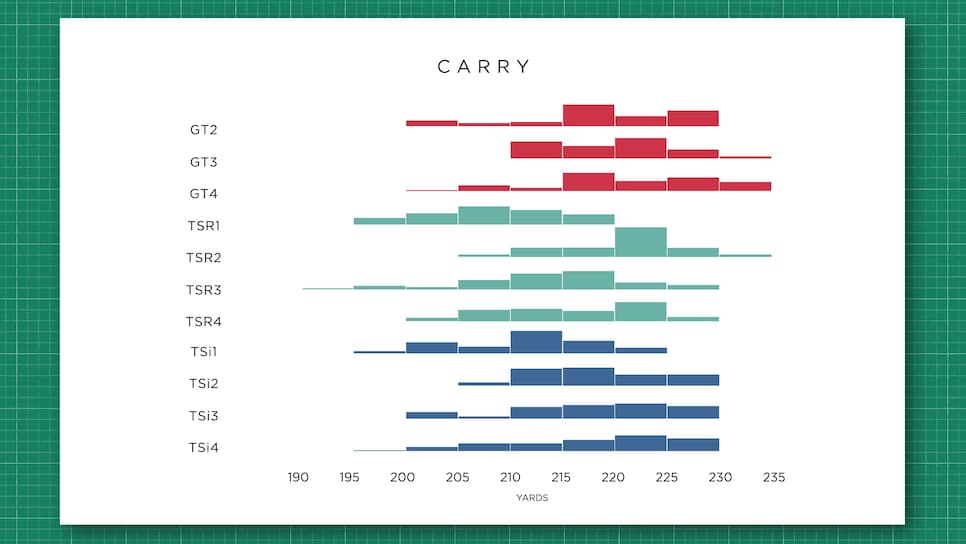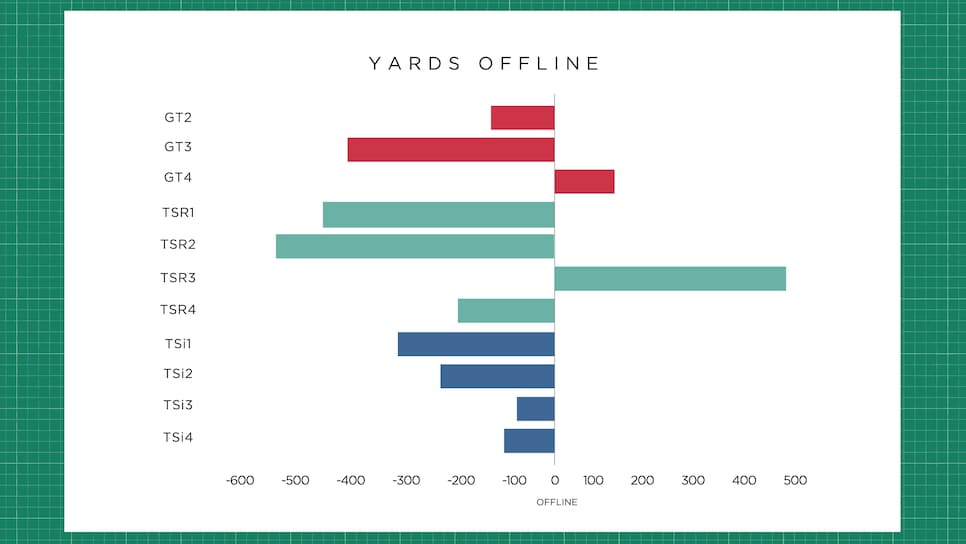Slow, spinny, short on distance. These are words that have been used to describe Titleist drivers before the arrival of TS. It could be argued that no manufacturer has chased distance harder than Titleist in the last 7 years — and it’s paid off in a big way.
The emergence of its ATI 425 face has made Titleist a major player in the driver category as it continues to chase more speed and longer drives.
RELATED: Take a closer look at Titleist’s New GT1 Metals Family
Of course, speed is worthless if you can’t keep it on the map.
We want a driver that can do it all, especially if you’re going to shell out $1,000-plus, which is what the new GT goes for these days.
This is where it pays to have a swing robot that can cut through the noise and offer an unbiased take on whether GT is worth the upgrade over TSR or TSi.
Testing protocol
When we test clubs, we run each 10.5-degree head at 95 mph — right around the average speed for an amateur golfer. This lets us gather a ton of useful data, from spin rate and dispersion to ball speed and carry distance across 9 different impact locations on the face. We also use the same shaft to create a true apples-to-apples comparison. We’re able to acquire meaningful data points for 90 percent of the face, so practically every kind of miss is accounted for.
1. Spin rate 
We spent way too much time analysing Titleist’s spin chart. In most cases, you’re able to understand pretty quickly what’s going on — but not with this one. In some cases, spins are going in different directions, as opposed to all trending up or down together.
Let’s start with the 2 model. On the low end, you can see spin dipped below 2,000 RPMs from TSi to TSR, while the high end of the spin range remained steady at 3,330. As I’ve said before, I’m not a huge fan of going below 2,000 because spin rates become unmanageable and you bring in the potential for a round-killing knuckleball.
With GT, we now seeing low spins get back to 2,200-2,300. It almost feels like they noticed spin was on the edge with TSR and simply moved the high-low range up to make it more playable. Something else I noticed? TSi2 and GT2 look eerily similar from a spin perspective.
RELATED: Titleist’s new T-Series irons and utility irons
GT3 is doing the opposite of GT2. We’re going from more of a mid-spin range with TSi to a slightly higher rate with TSR. And then GT3 goes the opposite direction and becomes a low-spin rocketship. A whopping 36 of the 54 shots recorded a spin rate between 1,800 and 2,500 RPMs. TSR2 and TSi2 had 14 shots end up in the same spin range. Combined. If you’re chasing distance through lower spin, GT3 is where it’s at.
Similar to TSi2 and GT2, the TSR4 and GT4 have similar spin ranges. They’re both relatively consistent, especially when compared to TSi4. Interestingly enough, the GT3 has a lower spin concentration than GT4.
2. Ball speed 
Ball speeds ticked up with GT3 and GT4, but from a pure speed perspective, it’s difficult to overlook TSR2’s strong numbers. It recorded more shots at 143 mph than any Titleist driver we tested. Not only that, it had 40 of the 54 shots recorded a ball speed from 138-143. It wasn’t faster than GT2 and TSi2 — it was noticeably faster.
GT3 takes the speed crown from TSR3 and TSi3 with a larger concentration of shots from 137-143 mph. Yes, everyone wants to play the fastest driver in the marketplace, but you’d be better off looking at a chart like this that’s logging shots from 9 different spots on the face to determine where your good and bad shots could likely end up.
The 4 shows ball speed were noticeably less consistent from TSi4 to TSR4, but that’s since been shored up with GT4. We now have 39 shots at 136-143 mph versus just 14 for TSi and 13 for TSR4. In other words, more consistent speed across the face.
3. Carry distance 
We already know TSR2 is a fast driver, but the carry numbers reveal it’s also incredibly long. Just look at the bar between 220 and 225 — that 26 is the number of shots it recorded within the carry range. Now compare it to GT2 and TSi2 which had a combined 19 shots in the same range.
The GT3 has a slight edge at the top end of the carry range but has some similarities to the TSi3. The TSR3, on the other hand, had a wider carry range than the other two. What I think gives GT3 the edge over TSi3 is that it didn’t record a single carry below 210, where you see TSi3 start to creep to 200. The overall range is exceptionally tight.
And it’s more of the same for GT4 as it breaks the 230-235 barrier for the first time. It actually recorded more shots from 215-235 than TSR2, which is fascinating when you consider the GT2 is 460cc and the GT4 is 430cc. Reducing the head size doesn’t impact forgiveness and distance in this case.
4. Dispersion 
And now to the final piece of the performance puzzle — dispersion. What’s intriguing about this chart is the tight dispersion patterns for TSi. This was the first year they introduced the ATI 425 face, and already they had something cooking. They are relatively close to centreline and tighter than TSR.
Graphics like these confirm TSi is still a very good driver.
RELATED: Titleist GT1 driver, fairway woods, hybrid: What you need to know
From the newest crop, the GT4’s dispersion was exceptional, especially when it’s pitted against the TSR4 and it’s noticeably wider shot band. I think it’s fair to say GT4 should be on the testing list for better players or those who don’t mind playing a slightly smaller profile.
The GT2 and GT3 have a slight left bias, but it’s still close to centreline. The tighter dispersions are no doubt an upgrade from TSR, and moderately straighter than TSi in some instances.
5. Who should upgrade?
I think the GT4 is a literal no-brainer. You’d be crazy not to test it if you’re currently in TSR4 or TSi4. Just like we’ve seen from other low-spin drivers in the marketplace, the GT4 doesn’t sacrifice forgiveness for spin. I think the driver has gotten better as the spin has decreased. It was exceptionally straight and had plenty of juice in the tank. That’s a killer combo.

If you’re playing TSi2, I’d run, not walk, to your local golf store and pick up a TSR2. The combination of speed and consistent launch and spin numbers stands out in a crowded driver pack, and the left bias is ideal if you continually fight a slice. And for those who currently have a TSR2, I’d hold onto it and enjoy the ride.
The GT3 also makes it incredibly easy to shed spin and chase distance if you’re content living in a spin range around around 1,800 to 2,500 RPMs. If you felt the spin was too high with TSi3 and TSR3, this could be your answer.
6. Who should not upgrade?
The most obvious is a golfer playing TSR2. Hard as manufacturers try to make every model better than its predecessor, it doesn’t always happen. The robot confirmed TSR2 and GT2 are neck-and-neck in carry, but the TSR2 gained a slight edge with more distance at the top end.
Both are great drivers, but I’m not sure the improvements are enough to warrant an immediate change.
